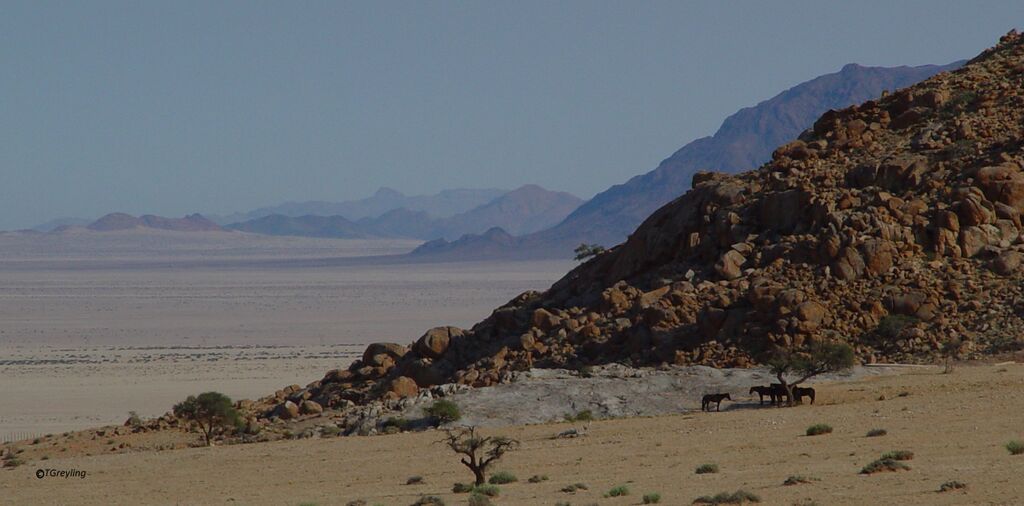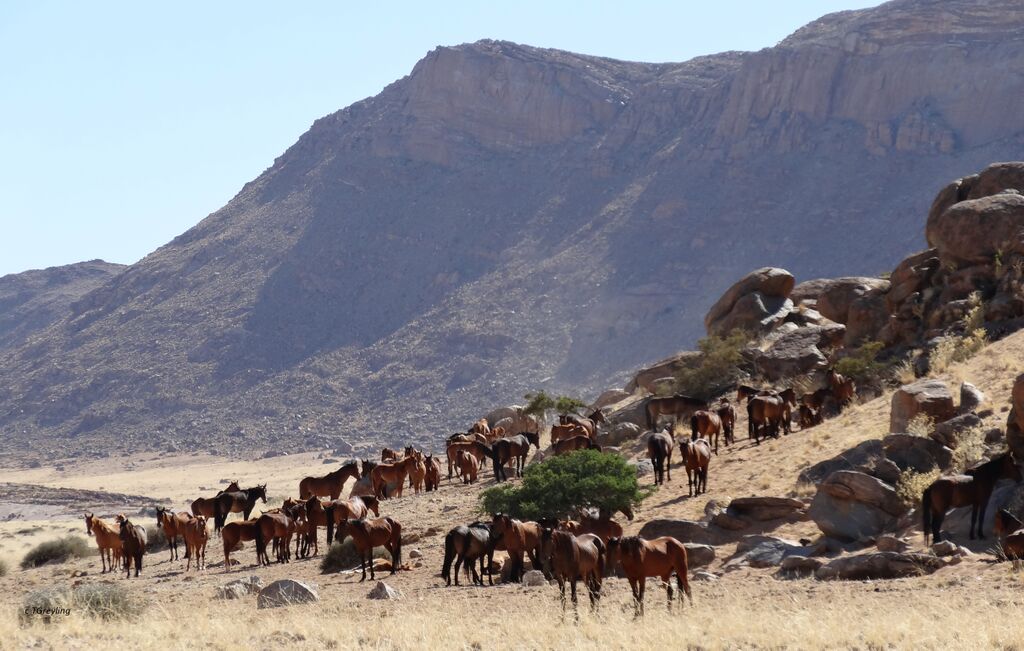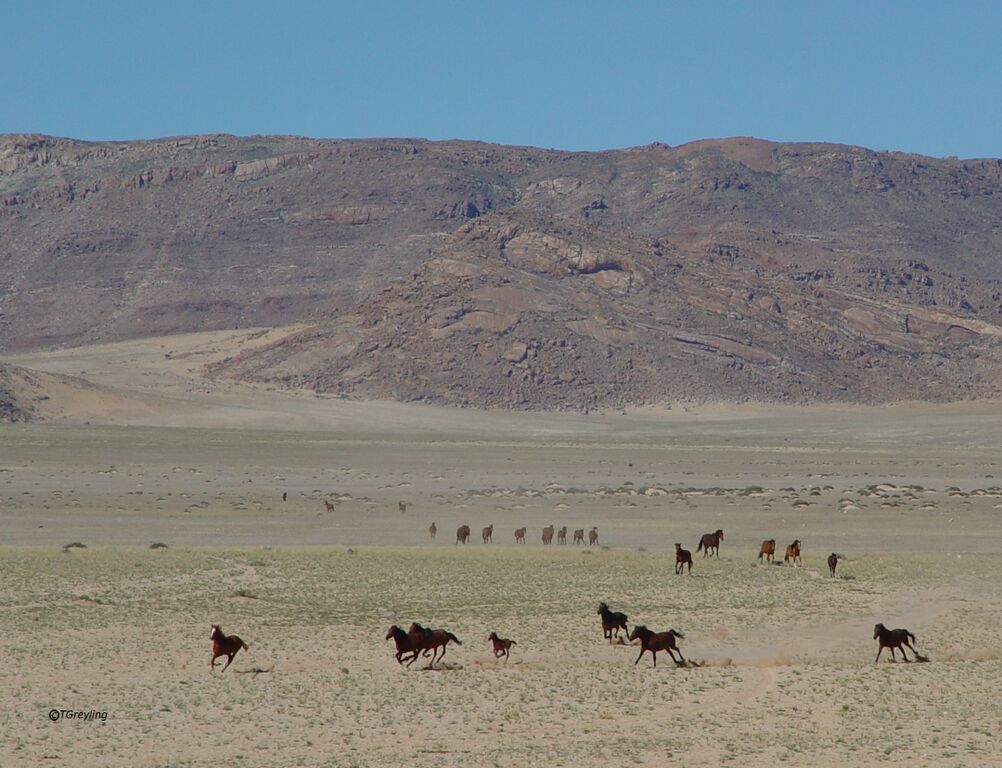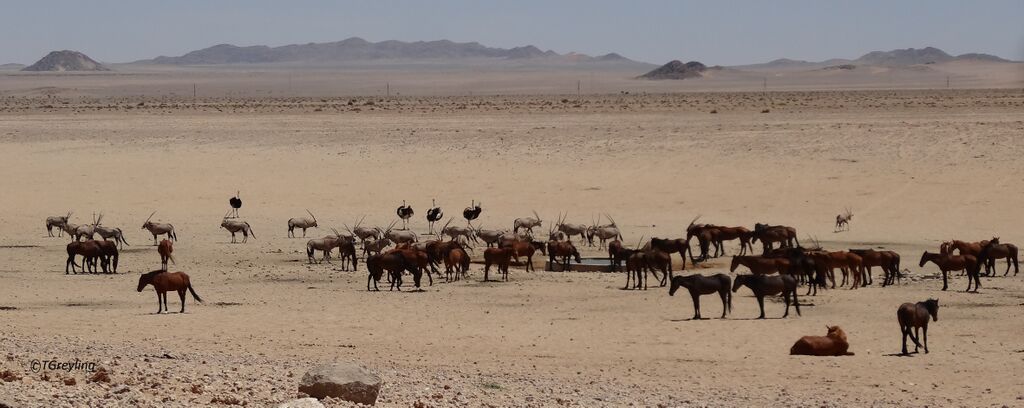This entry was contributed to Wild Equus by Dr. Telané Greyling of the Namibia Wild Horses Foundation, member and specialist of the Wild Equus Network (WEN). You can visit the foundation website, where you will find more details about her work with the feral horses at the Namib Naukluft National Park.
Species: Equus caballus
Subspecies/Breed/Type: Namibia Desert horses
Country: Namibia
Region/Province/Range: Namib Naukluft National Park
Population type: Semi feral – slightly managed
Estimated Population size: about 175 horses (2015)
Management Authority: Government Agency – Ministry of Environment and Tourism
Details of Population
These horses’ ancestors became wild around 1914-1924 and were able to live relatively undisturbed since the area they inhabited was a restricted diamond area, the “Sperrgebiet”. The horses had little influence from people except for the railway line and station at Garub, where they could get water. The origin of the horses is believed to be mainly from a horse stud which were abandoned around 1921 and the stud’s horses joined horses already grazing on the Garub plains since the First World War, many horses of the Allied Forces, stationed at Garub for two months, were scattered by bombing from the German forces. These ancestors were believed to be mainly crossbreds of Cape Horses, Trakener, Hackney and Thouroughbred bloodlines. The present horses are of small and light built, about 14-15 hands tall and weighing around 400 kilograms.
The area the horses inhabit were incorporated into the Namib Naukluft National Park in 1986 from when on an interest in management of the horses by the Namibia Ministry of Environment and Tourism became relevant. Population estimates were made in 1988 and 1991 and the population reduced by capture in a drought during 1992. The remaining population of 117 horses were individually identified and catalogued in December 1993 and has been monitored ever since. Another severe drought during 1998 caused the near removal of the horses from the desert, the controversy between proponents and opponents within the National Park authorities and the public led to a study on the ecology of the area during 2003-2005. A subsequent policy was accepted that the horses will be protected within the Namib Naukluft National Park with minimal interference, though ensuring a stable population within upper and lower limits.
Structure and demographics
During the past 20 years the population size has fluctuated between 89 and 286 horses. Good rainfall years in the late 80’s were followed by severe droughts in the 90’s and then followed by 12 years of abundance that ended by 2012. At present the Southern Namib are in the mid of a dry cycle again. Apart from malnutrition during drought, other mortality factors include predation mainly by spotted hyena, motor vehicle accidents on the B4 road to Lüderitz, fatal injuries, old age and complications (dystocia, etc.) while giving birth.
The population is typically structured in breeding groups, which consists of a stallion (sometimes 2 or more), adult mares, their offspring as well as youngsters not related to the adults. Peripheral stallions are also part of some groups, these stallions are not allowed interaction with adult mares in the group but contributes to the cohesion of the group by looking after youngsters and being a buffer zone around the group. Stallions not associated with breeding groups are called bachelor stallions who live alone or associate in small groups. At present the 175 horses are distributed into 32 breeding groups (ranging from 2 to 7 individuals) and 56 bachelor stallions. The sex ratio is 62% stallions to 38% mares and 78% adults to 22% juveniles (less than 5 years old). The main periods of significant changes in groups during the past 20 years have been influenced or caused by human interference (removal of horses) and severe droughts.
Issues worth noting and needed actions
Regarding policy and local opinion the population at Garub are secure, threats include severe drought and increased predation, therefore the activity of spotted hyenas in the area are being monitored and preparation for provision of a supplement protein mineral lick is in process.
Bibliography and further reading:
Please see more at Namibia Wild Horses Foundation
If you have further information or images you would like to share please contact us by email.
More entries to the Wild Equus Atlas;
Venezuelan Creoles WE – Entry from Dr. Jose Luis Canelon
Pottoka Piornal ponies WE – Entry from Lucy Ress
Pryor Mountain wild horses WE – Entry from Dr. Jason Ransom
McCullough Peaks horses – Entry from Dr. Jason Ransom
Aveto horses (WE) – Entry from Evelina Isola
Galician wild ponies WE – Entry from Dr. Laura Lagos
Namibia Desert horses WE – Entry from Dr. Telané Greyling
Delft Island horses WE – Entry from Wild Equus
Little Book Cliffs Wild Horses WE – Entry from Dr. Jason Ransom
Gower ponies WE – Entry from Jennie Nellist
Baguales WE – Entry from Dr. Victor Moraga and Enrique Zunzunegui
Exmoor Ponies WE – Entry from Sue McGeever
Tornquist feral horses WE – Entry from Dr. Alberto Scorolli
Sabucedo horses WE – Entry from Ivan Sanmartin Eirin
Cumberland Island horses WE – Entry from Wild Equus
Feral horses of Cotopaxi WE – Entry from Javier Solis Méndez, Lucy Rees, Johanna Marlès and Juan Bermeo
Please share this initiative far and wide. Gracias!
This is an ongoing work, and as such, will be updated regularly as new information is made available.







